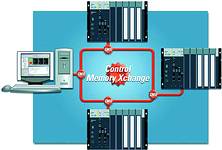
All manufacturers are concerned with increasing productivity and throughput while at the same time eliminating downtime and reducing maintenance costs. Generally, plant productivity is considered from a macro overview of the process, but this may not reveal improvements to be had from a micro view of individual plant systems and machines.
With the evolution of industrial communications systems such as GE Fanuc's PACSystems Control Memory Xchange - which offers far greater bandwidth and throughput than conventional carriers such as Ethernet, Profibus, and DeviceNet - data from industrial control systems is available at a much higher resolution than ever before.

A plant-wide historian such as Proficy Historian can connect to all manufacturing systems as well as the enterprise to provide the foundation for a vast information archive - one that is much more robust than a traditional relational database. A process historian can lower the cost of implementation, help to improve electronic record security, and offer users a way to make most effective use of their investments to analyse manufacturing data - and make significant improvements.
In combination with GE Fanuc's hardware and software technology, Binnington Development Corporation's FOCUS HSDA high-speed data acquisition system can read all the data tables in the control system 100 times per second (10 millisecond resolution) or more. The data from PLCs, drive controllers and similar control systems can help users to both optimise and improve maintenance of automated, complex, repetitive operations.
Driving data
High-speed data acquisition makes it possible to optimise a system using information from the controllers to reveal small flaws in sequencing. Valves opening fractions of a second too soon or too late, motors starting or stopping a few hundredths of a second late, sensors not being detected in a timely manner are common sequencing errors that may only be in the range a few hundredths of a second and not be detectable with conventional means. While one of these flaws may not make a significant difference to the process, the cumulative effect may be dramatic.
Pulp mill example
An example of this involves a hydraulic press in a pulp mill in Alberta, Canada. The entire plant production is run through the press to create bales of pulp for shipping. The press was known to be a major bottleneck in the plant, but the maintenance staff was reluctant to speed it up without being able to visualise the numerous interactions in the PLC system. Capturing and displaying the control system operation every 10 milliseconds revealed a number of small sequencing errors in the machine cycle. With greater visibility, the team was able to eliminate the missteps from the control system program. This technique helped the team reduce the cycle time of the press from approximately 45 seconds to less than 36, a reduction of 20% or more resulting in an estimated $15 000 per day in additional production.

For the first time, the team saw on the plant graphics system the small hydraulic spikes caused by valves or pumps operating a few milliseconds out of sequence. As the press was tuned up, it ran more smoothly. This was clearly illustrated by the reduction of the noise level in the machine room. The resultant reductions in mechanical wear and tear on the machine resulted in fewer component failures and thus savings in maintenance and improved uptime.
With the evolution of industrial communications systems such as GE Fanuc's PACSystems Control Memory Xchange - which offers significantly greater bandwidth and throughput than conventional carriers such as Ethernet, Profibus, and DeviceNet - data from industrial control systems is available at a much higher resolution than ever before.
Eliminating unscheduled shutdowns
Maintenance procedures - and uptime - are enhanced when teams can detect and eliminate hardware faults in sensors, actuators, and internal. For example, a steel mill in California was plagued by intermittent shutdowns on their galvanising line. The shutdowns were thought to be flickering photo eyes and other sensors that happened too quickly to be detected by their existing datalogging software.
Attempts to build traps in logic were unsuccessful due to the large number of control points to be monitored.
With production shutdowns costing thousands of dollars per minute, the 10- to 15-minute shutdowns every two to three weeks were extremely expensive. The company's new high-speed data acquisition is configured to read and log some 20 000 points from the data tables in the four PLCs controlling the line. At a sampling rate of 10 milliseconds, the system captures every transition and event in the PLCs as well as any device interacting with them. The team can view the information on the plant's GE Fanuc HMI system. The data is logged for 10 days and may be archived for later analysis as well. Analysis of the data has helped the team greatly decrease the shutdowns - with still more significant opportunities for improvement in the works.
Historically, intermittent faults have been the hardest to track down in an industrial control system. The fault occurs; the system grinds to a halt; materials in the system are scrapped and must be removed before start-up, and the energy and time expended to process those wasted materials are lost forever. If the cause of the fault is not revealed at the time it occurs, it is likely to arise again with subsequent further downtime, cost, and loss of productivity.
The high-speed data acquisition system will capture the fault and allow maintenance staff to repair or replace a sensor - or other component - before it causes another unscheduled shutdown.
Analysis of data may also reveal early signs of component and process degradation. Variations in machine cycle times over a period of time may indicate equipment wear or even changes in raw materials. That knowledge allows for improved preventative maintenance and the ability to change out devices on scheduled shutdowns rather than on unexpected failures.
Improving quality
Quality control may be enhanced through the analysis of the high-speed data. Small changes in the process due to fluctuations in raw materials or simple machine wear and tear may be discovered. Once detected, steps may be taken to return the process to its optimum state for the current operating conditions. Additionally, smoother production with fewer unscheduled shutdowns can make for a boost in quality.
With the advent of such technology as the PACSystems Control Memory Xchange, Proficy Historian and the FOCUS HSDA, manufacturers now can have a window into the operations of individual machines and systems that had previously been unavailable. As the granularity of the data is increased so are the opportunities to make small but significant improvements in the operation of the plant.
It is the cumulative effect of these miniscule changes of a few hundredths of a second here and a few milliseconds there that will yield the optimum efficiency and maximum productivity for any automated, complex, repetitive, industrial operation - from hydraulic presses in pulp mills to steel production lines to packaging operations.
For more information contact Daniel Coetzee, GE Fanuc Automation, 031 583 2602, [email protected], www.gefanuc.com

© Technews Publishing (Pty) Ltd | All Rights Reserved